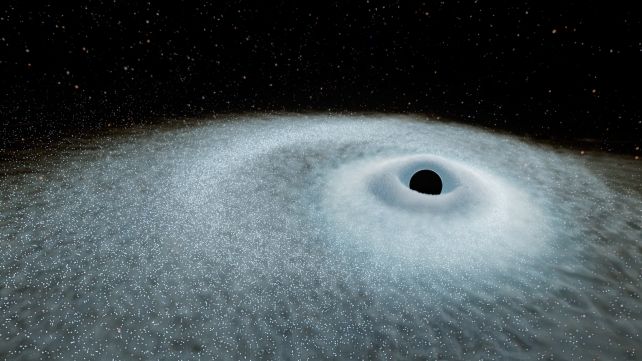A never-before-seen type of giant space explosion – the biggest bangs since the Big Bang – has been accidentally captured by the Gaia space telescope.
From the hearts of distant galaxies, the mapping telescope recorded sudden, extreme increases in brightness – colossal flares of light that lingered far longer than any such flares had been known to previously.
These blasts were calculated to release as much energy as 100 Suns would over the course of their combined lifetimes.
Analysis of that light revealed something that was both new and familiar at the same time: stars being torn apart by black holes, but on a scale we hadn't observed before.
Each star was a large one, at least three times as massive as the Sun; and each black hole was a supermassive beast lurking in the center of the star's host galaxy.
Such events are usually known as tidal disruption events, or TDEs. Astrophysicists are calling these new ones 'extreme nuclear transients' – ENTs for short.
"We've observed stars getting ripped apart as tidal disruption events for over a decade, but these ENTs are different beasts, reaching brightnesses nearly 10 times more than what we typically see," says astrophysicist Jason Hinkle of the University of Hawaiʻi's Institute for Astronomy (IfA).
"Not only are ENTs far brighter than normal tidal disruption events, but they remain luminous for years, far surpassing the energy output of even the brightest known supernova explosions."
The rather tame term 'tidal disruption' is used to describe what gravitational forces do to an object that gets too close to a black hole. At a certain point, the power of the external gravitational field surpasses the gravity holding an object together, and it comes apart in a wild scream of light before at least partially falling into the great unknown beyond the black hole's event horizon.
There are telescopes trained on the sky to catch these screams, applying a wide field of view to take in as much of the sky as possible, waiting for those unpredictable flares that denote the death throes of an unlucky star. Astronomers have managed to observe a good number of TDEs, and know roughly how they should play out.
There's a sudden brightening in a distant galaxy, with a light curve that rises to a rapid peak before gradually fading over the course of weeks to months. Astronomers can then analyze that light to determine properties such as the relative masses of the objects involved.

Gaia was a space telescope whose mission was to map the Milky Way in three dimensions. It spent a great deal of time staring at the sky to capture precise parallax measurements of the stars in the Milky Way. On occasion, however, it managed to exceed its mission parameters.
When combing through Gaia data, Hinkle and his colleagues found two strange events: Gaia16aaw, a flare recorded in 2016; and Gaia18cdj, which the telescope caught in 2018.
Both events bore a strong similarity to an event recorded by the Zwicky Transient Facility in 2020. Because that event was so insanely powerful, and because it was given the designation ZTF20abrbeie, astronomers nicknamed it "Scary Barbie".
Hinkle and his team determined that Gaia16aaw and Gaia18cdj are the same kind of event as Scary Barbie, and set about trying to figure out what caused them. They ruled out supernova explosions – the events were at least twice as powerful as any other known transients, and supernovae have an upper brightness limit.
A supernova, the team explained, typically releases as much light as the Sun will in its entire, 10-billion-year lifespan. The output of an ENT, however, is comparable to the lifetime output of 100 Suns all rolled together.

Rather, the properties of the ENT events, the researchers found, were consistent with TDEs – just massively scaled up. That includes how much energy is expended, and the shape of the light curve as the event brightens and fades.
ENTs are incredibly rare – the team calculated that they are around 10 million times less frequent than supernovae – but they represent a fascinating piece of the black hole puzzle. Supermassive black holes are millions to billions of times the mass of the Sun, and we don't have a clear idea of how they grow. ENTs represent one mechanism whereby these giant objects can pack on mass.
"ENTs provide a valuable new tool for studying massive black holes in distant galaxies. Because they're so bright, we can see them across vast cosmic distances – and in astronomy, looking far away means looking back in time," says astrophysicist Benjamin Shappee of IfA.
"By observing these prolonged flares, we gain insights into black hole growth during a key era known as cosmic noon, when the universe was half its current age [and] when galaxies were happening places – forming stars and feeding their supermassive black holes 10 times more vigorously than they do today."
The research has been published in Science Advances.
